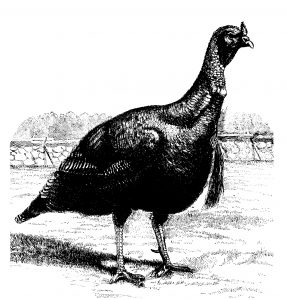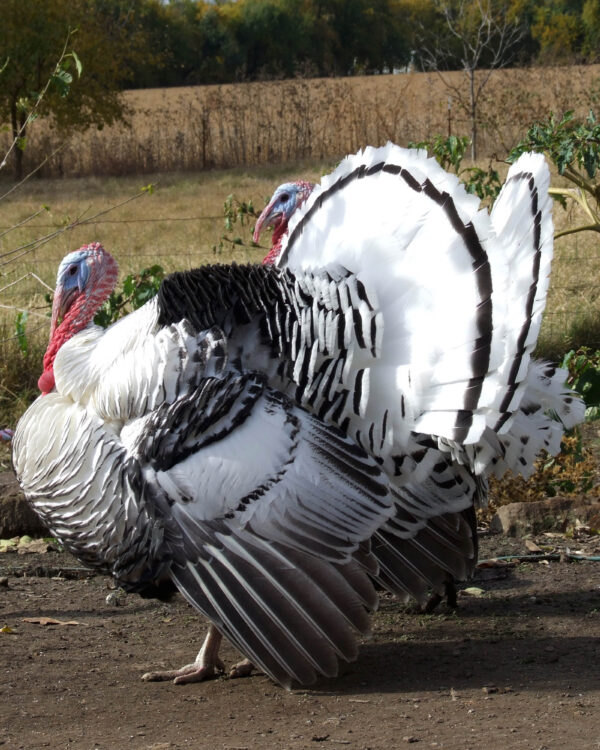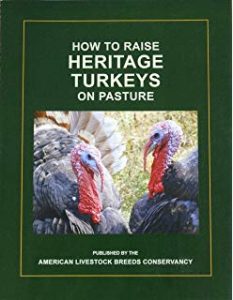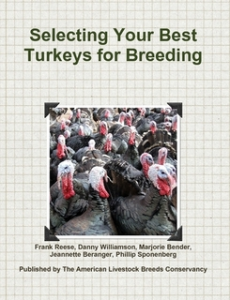
Breed Facts
Status:
Watch
Use:
Meat, Exhibition
Egg Color:
Pale cream to medium brown with spotting
Egg Size:
Large
Weight:
Male Young – 16 lbs. Mature – 20-22 lbs.
Female Young – 10 lbs. Mature – 12 lbs.
Temperament:
Highly dependent on socialization selection by breeder; some select for aggressive, others docile. Toms may pick on other species if kept together.
Characteristics:
Good flyers; excellent foragers; curious and like people.
ROYAL PALM TURKEY
The Royal Palm is a strikingly attractive and small-sized turkey variety. The first birds in America to have the Palm color pattern appeared in a mixed flock of Black, Bronze, Narragansett, and Wild turkeys on the farm of Enoch Carson of Lake Worth, Florida in the 1920s. Since then, further selection has been made to stabilize the consistency of color and other characteristics. As an anonymous breeder wrote to Feathered World magazine in 1931, “Turkeys of this type of coloration do crop up by chance where different color varieties are crossed . . . but it takes years to perfect their markings.” The Royal Palm was recognized by the American Poultry Association in 1971. It’s similar to a European variety called the Pied, Crollwitz, or Black-laced White, which has been known since the 1700s.
Royal Palm turkeys are white with a sharply contrasting, metallic black edging on the feathers. The saddle is black which provides a sharp contrast against the white base color of body plumage. The tail is pure white, with each feather having a band of black and an edge of white. The coverts are white with a band of black, and the wings are white with a narrow edge of black across each feather. The breast is white with the exposed portion of each feather ending in a band of black to form a contrast of black and white similar to the scales of a fish. The turkeys have red to bluish white heads, a light horn beak, light brown eyes, red to bluish-white throat and wattles, and deep pink shanks and toes. The beard is black.
These thrifty turkeys are active, excellent foragers, and good flyers. Standard weights are 16 pounds for young toms and 10 pounds for young hens. The Royal Palm hasn’t been purposefully selected for either growth rate or muscling, being used primarily as an exhibition variety.
The Royal Palm lacks the commercial potential of the other varieties, but it has a role to play on small farms, for at-home meat production, or where its ability to control insect pests would be of value.
Did you know:
When farms and farmers face a crisis, rare livestock breeds are more likely to be lost. That’s why The Livestock Conservancy offers Emergency Microgrants year-round. As the economy tightens, off-farm jobs are lost, herds are downsized, veterinary emergencies happen, and calamities such as floods, fires, and tornadoes continue. Help us help them. Click here to support the Emergency Response Fund with your gift today.
You may be interested in…

Breed Facts
Status:
Watch
Use:
Meat, Exhibition
Egg Color:
Pale cream to medium brown with spotting
Egg Size:
Large
Market Weight:
10 – 16 lbs
Temperament:
Highly dependent on selection by breeder, Some select for aggressive, others docile
You may be interested in…




